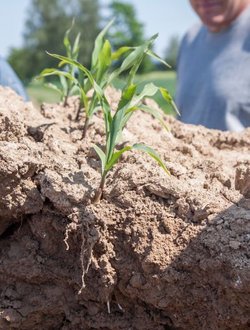UNDERSOWING AND INTERCROPPING
TO SUPPORT SOIL FERTILITY
"...learn how to use intercrops correctly might be one of the best investments."
M. Archambeaud
 Enough organic matter and healthy soil are the main conditions for maintaining soil fertility. The reduced function of the ecosystem cannot be sustainably on a long-term basis compensated by higher doses of inputs such as fertilizers or plant protection products. It is necessary to look for other solutions. The use of appropriately selected methods of undersowing and intercropping in purposefully aimed crop rotations positively affect soil fertility, production and stability of the yield.
Enough organic matter and healthy soil are the main conditions for maintaining soil fertility. The reduced function of the ecosystem cannot be sustainably on a long-term basis compensated by higher doses of inputs such as fertilizers or plant protection products. It is necessary to look for other solutions. The use of appropriately selected methods of undersowing and intercropping in purposefully aimed crop rotations positively affect soil fertility, production and stability of the yield.
Soils with a sufficient supply of organic matter are more resistant to climate changes. They provide the natural nutrient cycling and support the biological activity. Maintaining a certain level of organic matter in the soil is also a precondition for meeting the requirements of the good agricultural practice.
Benefits
INCREASE OF SOIL FERTILITY
- Symbiotic nitrogen fixation
- Better use of applied fertilizers, accumulation of nutrients in the organic matter and making them available for the crop
- Formation of the high-quality organic matter, improvement of the balance of humus and organic carbon content in the soil
- Stimulation of the biological soil activity
ECONOMIC BENEFITS
- Easier processing of structured soils reduces fuel costs
- Reduction of costs of mineral fertilizers
- Support of the yield and quality of the main crop
- Possibility to use the crop for feeding purpose
IMPROVEMENT OF SOIL STRUCTURE
- Reducing soil compaction and erosion control
- Formation of the soil structure due to the action of root systems and increasing the organic matter content
- Better use of rainfalls and restriction of unproductive evaporation
- Perennial covering and protection of the soil surface
REGULATION OF PEST AND WEED INFESTATION
- Soil covering reduces weeds
- Phytosanitary effect
- Disruption of development cycles of pests, antinematoid protection
- Disruption of cereal sequences, including legume crops
- Reduction of occurrence of diseases transmissible in the soil

Comments